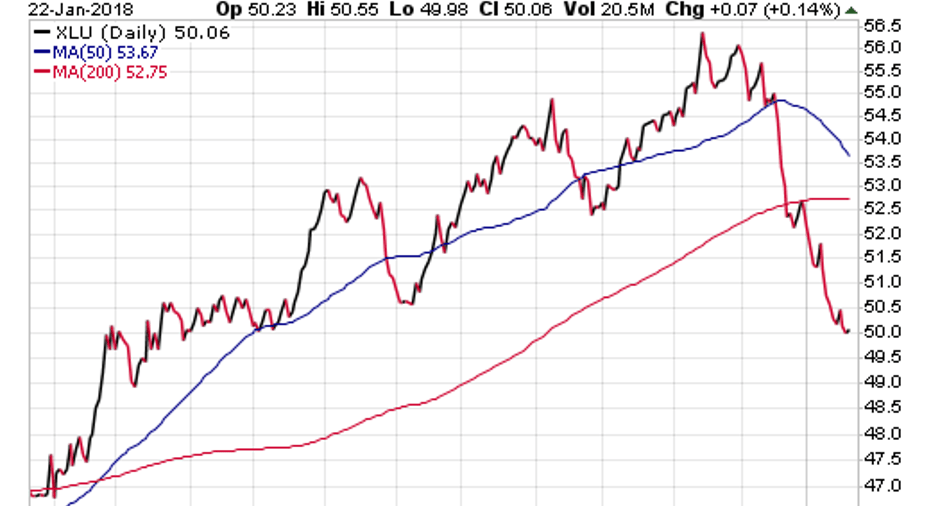Should ETF Investors Worry About Their Interest-Rate Sensitive Stocks?

This article was originally published on ETFTrends.com.
Stocks have come roaring out of the gate to start 2018 as the bull market extends to unprecedented heights. Momentum and volatility-agnostic investors have been treated to a continuation of the same strong trends that dominated last year’s markets. Yet, even with so much enthusiasm spread among the major diversified indices, there remains lackluster sentiment for many interest-rate sensitive stocks and sectors.
Interest-rate sensitivity has traditionally been the realm of fixed-income, where bond prices and bond yields are negatively correlated. Nevertheless, there are many areas of the U.S. equity markets that also key in to the fluctuations of U.S. Treasury yields. The foremost of which are utility, REIT, and financial stocks.
The connection has always been that rising yields are a net positive for financial stocks. This dynamic creates wider margins on traditional banking, financing, and insurance-related activity. The exact opposite is true for the utility and real estate sectors. Both of which rely heavily on debt and collateral obligations to fund growth and ongoing business operations. Those conventional correlations have continued to stand up over the last three months as the 10-Year Treasury Yield swung from an October low near 2.275% to a new cycle high of 2.65%.
This jump in interest rates, while not overly catastrophic to diversified bond investors, has put a damper on funds such as the Utilities Select Sector SPDR (XLU). This exchange-traded index fund tracks a basket of 28 large-cap utility stocks from within the broader S&P 500 Index. Top holdings include companies such as NextEra Energy Inc (NEE), Duke Energy Corp (DUK), and Dominion Energy Inc (D).
Since topping out in mid-November, XLU has tumbled over 12% and recently hit new year-to-date lows. It’s also notable that this fund is the only major S&P sector below its long-term 200-day moving average.
The most interesting thing about this decline is that it has occurred as the rest of the market has continued to push to new all-time highs. The lone dynamic of interest rates has taken their toll on utilities as investors pullback their risk appetites for these stalwart companies.
The flip side of course is that XLU is now far more attractive for those with a relative value mindset who may opt to consider their stable dividend streams and historically lower volatility. This ETF now sports a dividend yield of 3.53%, which is more than double that of the SPDR S&P 500 ETF (SPY).
Another sector feeling the sting of interest rate activity is the Real Estate Select Sector SPDR Fund (XLRE). This ETF and many of its peers such as the Vanguard REIT ETF (VNQ) have seen prices fall 6-8% over the last two months and are currently trading below the flat line for the year.
Real estate stocks haven’t experienced quite the same measurable price decline as utilities, but still sport obvious sensitivity to higher financing rates. Some of the larger companies that make up this group include Public Storage (PSA) and AvalonBay Communities (AVB).
Many income investors love the attractive yields that these sectors provide in comparison to other growth-focused industries. Yet that same dynamic is also why these stocks can diverge from the momentum of the broader market. They can often assume characteristics of bonds as risk appetites shift along varying cycles.
The Bottom Line
The short-term underperformance of any sector is a common occurrence that must be evaluated within the context of why you own it or are considering a purchase to begin with. The overriding risk factor in this situation is the continued ascent of interest rates weighing on future gains in both utilities and REITs. Nevertheless, the market is often quick to undergo short bouts of anxiety that are just as soon alleviated as other themes or fears capture investor attention.
The views and opinions expressed herein are the views and opinions of the author and do not necessarily reflect those of Nasdaq, Inc.
This article was republished with permission from FMD Capital Management.
More from ETF Trends ETFs Could Revolutionize Bitcoin Access…if They Come to Market More ETF M&A: Mirae Asset to Acquire Global X Traders Take Another Look at a Regional Bank ETF Why Dollar Upside Could be Limited Traders Are Flocking to Bearish Volatility ETF